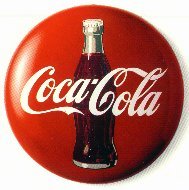|
From the late 1940s to the 1970s, the
United States, like most of world, changed at an unprecedented
pace. The Coca-Cola Company also experienced its most dramatic
changes in marketing and merchandising since the advent of
bottling in the 1890s. World War II had recast the world,
and the Company faced a new, more complex global marketplace.
Packaging. Until the mid-1950s, the world of Coca-Cola was
defined by a 6 1/2 -ounce hobble-skirt bottle or bellshaped
fountain glass. But as consumers demanded a wider variety
of choices, the Company responded with innovative packaging,
new technology and new products.
In 1955, the Company introduced the 10-, 12- and 26-ounce
king-size and fan-full size bottles, which were immediately
successful. Metal cans, first developed for armed forces overseas,
were available on market shelves by 1960. Then, following
years of research into plastic soft drink bottles, the Company
introduced PET (Polyethylene Terephthalate) packaging in 1977
in the 2-liter size.
Products. The Company also introduced new soft drinks to satisfy
a widening spectrum of tastes. Bom in 1960'm Germany, the
Fanta fan-ffly of flavored soft drinks has become the third
best-selling brand in the world. Sprite, a lemon-ffine drink,
followed in 1961, and in 1963 the Company introduced TAB,
its first lowcalorie beverage.
Change during the 1960s entafled more than new soft drinks.
In 1960 the Minute Maid Corporation merged with the Company,
adding frozen citrus juice concentrates and ades under the
trademarks Minute Maid and Hi-C to the Company's array of
beverages.
Advertising. Through the years, jingles and slogans have set
the pace for Coca-Cola advertising. One of the world's most
famous advertising slogans, "The Pause That Refreshes,"
first appeared in The Saturday Evening Post in 1929. It was
supported by "It's The Refreshing Thing To Do" in
1936 and 1944s "Global High Sign" The 1950s produced
"Sign Of Good Taste:' "Be Really Refreshed"
and "Go Better Refreshed".
|

Many more memorable slogans followed, including "Things
Go Better With Coke" in 1963. "It's The Real Thing,"
first used in 1942, was revived in 1969 to support a new,
tremendously successful merchandising stance for Coca-Cola.
Fine illustrations by top artists including Norman Rockwell
were featured in colorful ads that projected the product's
image in leading magazines. Noted artist Haddon Sundblom’s
popular Santa Claus "portraits," which began in
the 1930s, continued as holiday ads during the late 1950s
and early 1960s.
Since the mid-1920s, radio had been the most important communication
medium for Coca-Cola. In the 1960s, the popular "Things
Go Better With Coke" jingle became a hit radio spot,
using successftil groups like The Supremes, The Four Seasons,
Jan and Dean and The Moody Blues.
The Company's advertising changed along with the world, reaching
new groups of consumers through new channels, most notably
television. On Thanksgiving Day, 1950, Edgar Bergen and his
sidekick, Charlie McCarthy, appeared on the first five television
network show sponsored by The Coca-Cola Company. As the medium
evolved from program sponsor-ship to commercials that ran
during different shows,many famous celebrities advertised
Coca-Cola. Among the famous entertainers who appeared in Coca-Cola
television and radio commercials during the 1960s were the
McGuire Sisters, Aretha Franklin introduced in 1955. and Neil
Diamond.
Through the years, advertising for Coca-Cola has changed in
many ways, but the message, like the trademark, has remained
the same.
|







